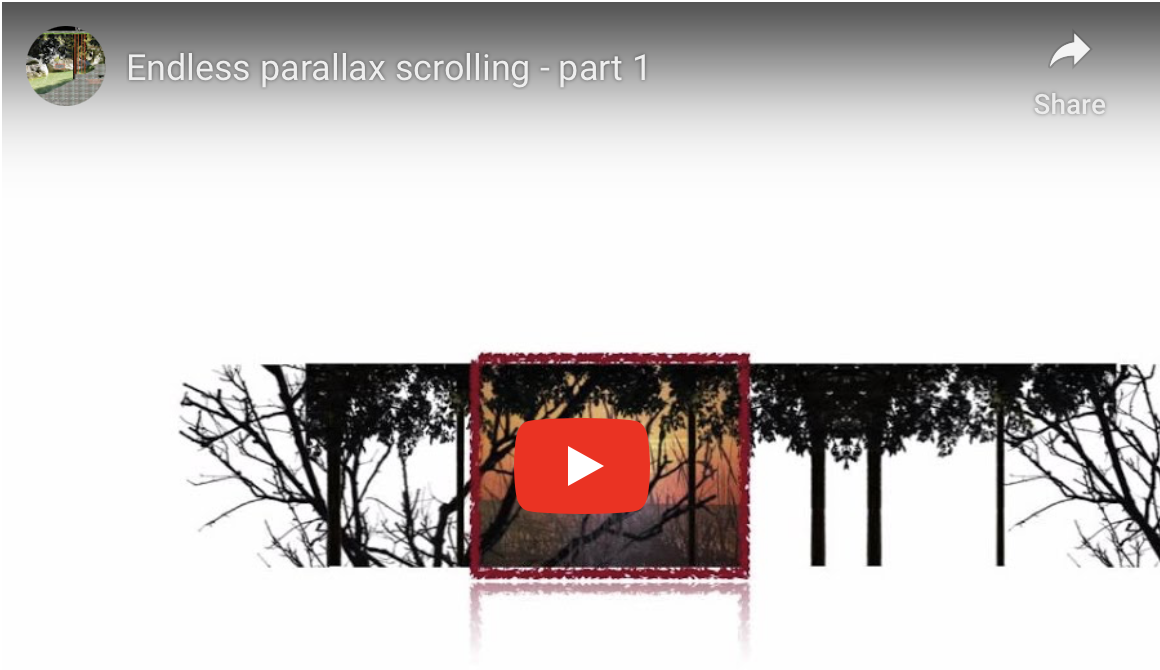HowTo: Implement endless scrolling with parallax effects
Welcome to Part 5 of my blog series about game development: Endless Scrolling
Today I’ll create a component which implements the endless scrolling and adds some parallax effects. I’ll use SpriteKit for that. A nice tutorial about SpriteKit can be found here and here.
If you haven’t completed part 3 or 4, you can download the project from GitHub: v0.3
First of all we need some background images to show the infinite parallax scrolling. I’ve created four layers:
Background:

BackgroundBush:

BackgroundTree:

BackgroundGrass:

Combining all images together looks like this:

Adding the images to out XCode project:
The size of textures for SKSpriteNode is limited. Therefore I’ll slice the background into tiles:

For example the Background image is only shown fullscreen without scrolling. The Bush background has a size of 4 screens. It is used for scrolling. Remember my last post: The first and the last screen must be identical!
One principle from the Apple design guidelines to provide an excellent user experience is: Do not scale!
That means we need multiple versions of our images in different resolutions.
(=> 4 versions, if we limit our target platform to iOS 7 or newer.)

Add the images to the Asset Catalog. If you are not familiar with Asset Catalog, Apple has a nice tutorial here.



Adding a SpriteKit Scene to our ViewController:
Now after creating many different images let’s start coding …
1. Add the SpriteKit Library to the project
Press ‘+’ to add a new library

Choose SpriteKit.framework

Add an import statement for SpriteKit to the MyFirstGame-Prefix.pch file

2. Create a new Scene:
Add a new file with type Objective-c class:

New file must be a subclass of SKScene:
A SKScene represents the content of a scene in Sprite Kit. It is the root node of other Sprite Kit nodes (SKNode)

Add another file to implement the endless scrolling:
This file must be a subtype of SKNode. A SKNode object can be added to our scene. It’s also possible to other nodes in a hierarchical order, one for every background.

3. Implement ParallaxHandlerNode
This class is derived from SKNode. It is the root element for all backgrounds/tiles which are created for the endless scrolling:
ParallaxHandlerNode.h:
#import <SpriteKit/SpriteKit.h>
@interface ParallaxHandlerNode : SKNode
-(id)initWithSize:(CGSize)Size;
-(void)addBackgroundLayer:(NSArray*)tiles;
-(void)scroll:(float)speed;
@end
The ParallaxHandlerNode class implements three methods:
- initWithSize - initializes the object
- addBackgroundLayer - adds a layer to the parallax hierarchy
- scroll - implements the endless scrolling for all layers
ParallaxHandlerNode.m:
#import "ParallaxHandlerNode.h"
@implementation ParallaxHandlerNode
CGSize _containerSize;
-(id)initWithSize:(CGSize)size {
_containerSize=size;
return [self init];
}
// Add a background layer.
-(void)addBackgroundLayer:(NSArray*)tiles {
// Create static background
if ([tiles count]==1 ) {
SKSpriteNode *background=[SKSpriteNode spriteNodeWithImageNamed:(NSString*)[tiles objectAtIndex:0]];
background.position=CGPointMake(_containerSize.width/2, _containerSize.height/2);
[self addChild:background];
} else {
// Create a background for infinite scrolling
// Create a SKNode a root element
SKNode *background=[[SKNode alloc]init];
[self addChild:background];
// Create and add tiles to the node
for (int i=0; i<[tiles count]; i++) {
NSString *item = [tiles objectAtIndex:i];
SKSpriteNode *tile;
if (![item isEqualToString: @""]) {
// Add an emtpy screen
tile=[SKSpriteNode spriteNodeWithImageNamed:item];
tile.position=CGPointMake(_containerSize.width/2+(i*_containerSize.width), 0);
} else {
tile=[[SKSpriteNode alloc] init];
tile.size=_containerSize;
tile.position=CGPointMake(_containerSize.width/2+(i*_containerSize.width), _containerSize.height/2);
}
[background addChild:tile];
}
// position background at the second screen
background.position=CGPointMake(-_containerSize.width, _containerSize.height/2);
}
}
// Infinite scrolling:
// - Scroll the backgrounds and switch back if the end or the start screen is reached
// - Speed depends on layer to simulare deepth
-(void)scroll:(float)speed {
for (int i=0; i<self.children.count;i++) {
SKNode *node = [self.children objectAtIndex:i];
// If more than one screen => Scrolling
if (node.children.count>0) {
float parallaxPos=node.position.x;
NSLog(@"x: %f", parallaxPos);
if (speed>0) {
parallaxPos+=speed*i;
if (parallaxPos>=0) {
// switch between first and last screen
parallaxPos=-_containerSize.width*(node.children.count-1);
}
} else if (speed<0) {
parallaxPos+=speed*i;
if (parallaxPos<-_containerSize.width*(node.children.count-1)) {
// switch between last and first screen
parallaxPos=0;
}
}
// Set new node position. Position can't be set directly, therefore tempPos is used.
CGPoint tmpPos=node.position;
tmpPos.x = parallaxPos;
node.position = tmpPos;
}
}
}
@end
4. Create the scene:
The GameScene class is inherited from SKScene and implements four methods:
initWithSize- initializes the objecttouchesBegan- reacts on touch events, changes speed and directionaddBackgrounds- adds the background layersupdate- the game loop
GameScene.m:
#import "GameScene.h"
#import "ParallaxHandlerNode.h"
// Constants
#define cStartSpeed 5
#define cMaxSpeed 80
@implementation GameScene
// private properties
NSTimeInterval _lastUpdateTime;
NSTimeInterval _dt;
int _speed=cStartSpeed;
ParallaxHandlerNode *background;
-(id)initWithSize:(CGSize)size {
if (self = [super initWithSize:size]) {
[self addBackgrounds];
}
return self;
}
// Increase speed after touch event up to 5 times.
// After maximum speed is reached the next touch changes the scroll direction
-(void)touchesBegan:(NSSet *)touches withEvent:(UIEvent *)event {
if (_speed<cMaxSpeed && _speed>-cMaxSpeed) {
_speed=_speed*2;
} else {
if (_speed<0) {
_speed=cStartSpeed;
} else {
_speed=-cStartSpeed;
}
}
}
// Add the background elements for parallax scrolling
-(void)addBackgrounds {
// Array contains the name of the background tiles. "" for adding an empty screen
NSArray *nameBackground = [NSArray arrayWithObjects: @"Background", nil];
NSArray *nameBush = [NSArray arrayWithObjects:@"BackgroundBushLeft", @"BackgroundBushRight", @"", @"BackgroundBushLeft", nil];
NSArray *nameTree = [NSArray arrayWithObjects:@"BackgroundTreeLeft", @"BackgroundTreeRight", @"BackgroundTreeLeft" ,nil];
NSArray *nameGrass = [NSArray arrayWithObjects:@"", @"BackgroundGrassCenter", @"", nil];
// Root node which contains the tree of backgrounds/background tiles
background = [[ParallaxHandlerNode alloc] initWithSize:self.size];
[self addChild:background];
[background addBackgroundLayer:nameBackground];
[background addBackgroundLayer:nameBush];
[background addBackgroundLayer:nameTree];
[background addBackgroundLayer:nameGrass];
}
// The GameLoop
-(void)update:(NSTimeInterval)currentTime {
// Needed for smooth scrolling. It's not guaranteed, that the update method is not called in fixed intervalls
if (_lastUpdateTime) {
_dt = currentTime - _lastUpdateTime;
} else {
_dt = 0;
}
_lastUpdateTime = currentTime;
// Scroll
[background scroll:_speed*_dt];
}
@end
5. Add the scene to GameViewController:
Add this method to GameViewController.h
-(void)viewWillAppear:(BOOL)animated{
[super viewWillAppear:animated];
SKView * skView = [[SKView alloc]initWithFrame:self.view.frame]; //(SKView *)self.view;
[self.view addSubview:skView];
skView.showsFPS = YES;
skView.showsNodeCount = YES;
// Create and configure the scene.
GameScene *gameScene = [GameScene sceneWithSize:skView.bounds.size];
gameScene.scaleMode = SKSceneScaleModeResizeFill; //SKSceneScaleModeAspectFill;
// Present the scene.
[skView presentScene:gameScene];
}
6. Deploy and run
Cheers,
Stefan

